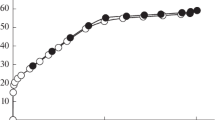Conclusions
-
1.
A simple model in which adhering and interpenetrating carbon crystallites form a series of micropore zones is proposed for use in discussing pore systems in carbon adsorbents.
-
2.
Finite-dimensional micropores are formed by burn-off of crystallite carbon atoms in the course of gas-phase oxidative activation (intracrystalline micropores) and by the development of interstices between adhering crystallites (intercrystalline micropores).
-
3.
The model micropore zone is assumed to have the form of a small cube. The fissure interstices between faces of these cubes, or micropore zones, represent the micropore volume, and the total wall surface area of these pores the mesopore surface area. Calculation of the values of the parameters of such micropore structures from minimal experimental data is illustrated for various actual adsorbents.
-
4.
The attempt is made to model the structures of micropore zones and estimate the values of their parameters.
Similar content being viewed by others
Literature cited
M. M. Dubinin, Izv. Akad. Nauk SSSR, Ser. Khim., 1691 (1979).
M. M. Dubinin and A. A. Isirikyan, Izv. Akad. Nauk SSSR, Ser. Khim., 13 (1980).
M. M. Dubinin, Izv. Akad. Nauk SSSR, Ser. Khim.,18 (1980).
M. M. Dubinin and H. F. Stoeckli, J. Colloid Interface Sci.,75, 34 (1980).
M. M. Dubinin, Dokl. Akad. Nauk SSSR,261, 2 (1981).
M. M. Dubinin, E. D. Zaverina, and L. V. Radushkevich, Zh. Fiz. Khim.,21, 1351 (1947).
M. M. Dubinin, Zh. Fiz. Khim.,39, 1305 (1965).
M. M. Dubinin and V. A. Astakhov, Izv. Akad. Nauk SSSR, Ser. Khim.,5, 11, 17 (1971).
M. M. Dubinin, Progress Surface Membrane Sci.,9, 1–70 (1975).
P. B. Hirsch, Proc. Roy. Soc.,A226, 145 (1954).
R. Diamond, Proc. Third Conference on Carbon, Pergamon Press (1959), p. 367.
M. M. Dubinin, Proc. Fourth Intern. Symposium on Reactivity of Solids, Amsterdam (1961), p. 643.
M. M. Dubinin, G. M. Plavnik, and E. D. Zaverina, Carbon,2, 261 (1964).
M. M. Dubinin and G. M. Plavnik, Carbon,6, 183 (1966).
M. M. Dubinin, I. T. Erashko, O. Kadlec, V. I. Ulin, A. M. Voloshuk, and P. P. Zolotarev, Carbon,13, 193 (1975).
M. M. Dubinin, Usp. Khim.,46, 1929 (1977).
M. M. Dubinin and E. G. Zhukovskaya, Izv. Akad. Nauk SSSR, Otd. Khim. Nauk, 535 (1958).
M. M. Dubinin and E. G. Zhukovskaya, Izv. Akad. Nauk SSSR, Otd. Khim. Nauk, 1705 (1959).
M. M. Dubinin and O. Kadlec, Carbon,13, 263 (1975).
D. A. Kol'shkin and K. K. Mikhailova, Active Carbon (Handbook) [in Russian], Khimiya, Moscow (1977).
Author information
Authors and Affiliations
Additional information
Translated from Izvestiya Akademii Nauk SSSR, Seriya Khimicheskaya, No. 2, pp. 246–254, February, 1982.
Rights and permissions
About this article
Cite this article
Dubinin, M.M., Fedoseev, D.V. Micropore systems in carbon adsorbents. Russ Chem Bull 31, 226–232 (1982). https://doi.org/10.1007/BF00948231
Received:
Issue Date:
DOI: https://doi.org/10.1007/BF00948231



